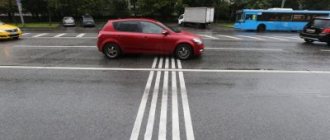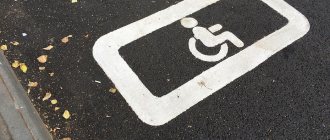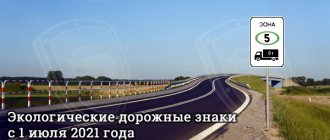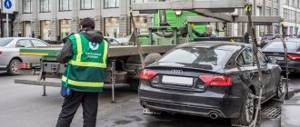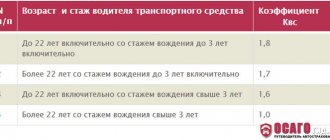Validity period of the “Working days”/”Weekends” sign
“Working hours” is an information designation that explains additional information under the main sign, indicating the time and days of the week. The following categories are distinguished:
Weekends and holidays.
The sign indicates a vehicle for which travel is prohibited during this time period. For example: January 2 from 00:00 to 04:00.
The sign is only active on specific weekdays.
It is indicated on what day the ban or permit operates.
Sign area
Sign 8.2.1 “Area of Action” occupies a special place. The plate is colored yellow if you need to temporarily limit the activity of other notifications. Types of signs:
1 Maintain a minimum distance and maximum speed.
2 Overtaking for trucks is prohibited.
3 Overtaking is prohibited for all vehicles.
4 Prohibition of the use of a sound signal.
Penalty for violation
Violation of traffic rules provides for both administrative and criminal liability, regulated by the Code of Administrative Offenses and the Criminal Code. The degree of liability depends on the severity of the offense.
This obligation rests with the driver of the vehicle, and penalties are regulated by relevant codes.
For ignoring the “working hours” signs, a payment of 500 rubles is provided. If the motorist turned around in the wrong place or stopped, then the cost of the fine will be from 1000 to 1500 rubles.
Lane direction signs
Last update: 02/15/2021
- Road signs for special regulations
- Signs of special regulations 5.1 - 5.4
- Signs of special regulations 5.5 - 5.10
- Signs of special requirements 5.11.1 - 5.14.3
- Lane direction signs
- Signs "Start of lane" and "End of lane"
- Signs of special regulations 5.16 - 5.22
- Signs Beginning and End of a settlement
- Signs of special regulations 5.27 - 5.32
- Signs Pedestrian zone and Bicycle zone
- Signs “Zone with environmental class restrictions”
In this part, we will look at road signs 5.15.1 “Directions of traffic in lanes”, 5.15.2 “Directions of traffic in lanes”, 5.15.7 “Directions of traffic in lanes”, 5.15.8 “Number of lanes”.
Let's consider what the listed signs are used for, how they differ from each other, despite the similarity in names, and also what fines are provided for violating traffic conditions on the lanes.
What if I need to turn right across a bus lane?
If at a given moment in time on a given section of the road you are prohibited from moving along the lane for buses, but exiting to the right into the adjacent territory is allowed only through it, then you are allowed to enter it to turn, but only in the place where the markings are not continuous, but either intermittent, or continuous with intermittent (where intermittent is on your side), or there are no markings at all.
This is allowed to us, in fact, by the second paragraph of clause 18.2 of the 2019 Traffic Regulations:
If this lane is separated from the rest of the roadway by a broken marking line, then when turning, vehicles must change lanes to it. It is also permitted in such places to enter this lane when entering the road and for boarding and disembarking passengers at the right edge of the roadway, provided that this does not interfere with route vehicles.
Is it possible to stop at a stop on the bus lane?
There are 2 points of the Rules governing this issue:
- clause 12.4 of the traffic rules indicates that it is prohibited to stop cars at stops and closer than 15 meters before and after them, except when boarding or disembarking passengers, and if this does not interfere with buses, trolleybuses - everyone for whom it is intended, as well as taxi cars;
- at the same time, clause 18.2 (last paragraph) prescribes that crossing a bus lane is only possible to pick up/drop off people and only if it is separated from the rest of the roadway by intermittent markings.
As a result, we get that you can stop in a bus lane solely to disembark or pick up passengers and only if you enter it without crossing a solid marking line.
What is the fine for driving in a bus lane?
But the amount of fines for driving into a designated lane for minibuses on weekends, if this is not permitted by special signs, varies for regions and for Moscow and St. Petersburg. For prohibited movement or stopping in such a lane, if the offense was committed in Moscow or St. Petersburg, you will be given a fine of 3,000 rubles, and in other cities - 1,500 rubles under parts 1.1 and 1.3 of article 12.17, respectively.
In addition, for stopping in the bus lane and not being there when this violation is detected, evacuation to the impound lot is also provided.
In large cities of the country, the problem of automobile traffic is acute. During rush hour, traffic on the roadway literally freezes in place. And only public transport partially avoids this fate by moving along dedicated bus lanes.
There are often drivers on the roads who ignore the regulations and travel together with public transport vehicles. This is done more often on weekends, especially in Moscow and St. Petersburg.
Also confusing is the sign known as crossed hammers. Many motorists are confident that it allows driving in a dedicated lane on weekends. In this article, we will figure out in what cases you can travel on a bus line, based on current traffic regulations.
Read also: Test drive what is it
What is the fine for driving in a bus lane in 2021?
So, let's first look at the penalties for driving on a dedicated lane, and below - for parking on it. And here the size of the sanction can be different, and this is what it depends on.
A separate amount of sanctions in Moscow and St. Petersburg
The maximum fine for traveling on a bus lane in two capitals of Russia is 3,000 rubles. In this case, part 1.2 of Article 12.17 of the Code of Administrative Offenses of the Russian Federation indicates that if you entered such a lane in Moscow or St. Petersburg, then you will be subject to an increased fine.
Fine for regions
If you drove along a bus lane in any other city, then your pocket will be emptied by an amount 2 times less - by 1,500 rubles. This is exactly the fine provided for in Part 1.1 of Article 12.17 of the Code.
What if this is an oncoming bus lane?
But here everything is more complicated. The fact is that administrative law has the principle “from the general to the particular”. In this situation, one violation entails essentially 2 penalties:
- fine for driving in a bus lane,
- fine or deprivation of license for driving in oncoming traffic.
However, it is prohibited to punish twice for the same traffic violation (Part 5, Article 4.1 of the Administrative Code). That is why in Article 12.17 you can see that a fine for segregation is imposed in all cases, except those where there is an offense under parts 3-5 of Article 12.15 of the Code. And these parts prescribe penalties for oncoming traffic:
- part 3 – for oncoming traffic while avoiding an obstacle with a fine of 1,000 to 1,500 rubles,
- part 4 – for prohibited overtaking, including; and here you will face either a fine of 5,000 rubles or deprivation of your driver’s license for 4-6 months,
- Part 5 provides for liability for a repeated violation under Part 4 with deprivation of rights for 1 year (or a fine of 5 thousand can only be in the case of an automatic recording camera).
Thus, the punishment for driving into an oncoming bus lane will be harsher than for driving into a passing bus lane.
Is there a discount on fines?
But let’s return to the fine specifically for the designated lane for route vehicles. There is a 50% discount on both penalties if you pay the fine to the traffic police within 20 days from the date the decision was issued against you.
Thus, the discounted amount in this case will be:
- 750 rubles fine for a bus lane in the regions of Russia,
- 1,500 rubles for travel on a dedicated bus in Moscow or St. Petersburg.
Do cameras catch this violation?
, quite. Most road photo and video recording equipment can recognize intersections and traffic in a bus lane. In this case, the owner of the car receives a corresponding fine by mail.
Will there be a parking lot?
No. There is no provision for vehicle towing for entering a bus lane.
By the way, it is not a separate type of punishment, but serves only to ensure access to free movement when a stationary car is in the way, or to prevent particularly serious violations from continuing - for example, driving while intoxicated. Accordingly, a special parking lot is assigned together with a resolution issued for any traffic violation.
And in our case, the Code of Administrative Offenses of the Russian Federation contains Article 27.13, Part 1, which lists other standards of liability under which evacuation is applied. And this list does not include a fine for a bus lane: neither in Moscow and St. Petersburg, nor in other cities, nor even if we are talking about deprivation of rights for driving into an oncoming lane.
Where did it all start?
The Soviet Union did not think about such a large number of cars on the streets of our cities in the future. Just like they didn’t think about it in any other country in the mid-20th century. The streets were built narrow, pedestrian, and the area around the houses was not equipped with parking. Therefore, cities with historical centers and buildings dating from the first half of the twentieth century are particularly affected by increased traffic.
The situation is complicated by the introduction of bus lanes. The roads have become even narrower. Drivers are forced to stand in traffic jams for hours. This gives rise to traffic violations and leads to fines.
Whether it’s good or bad, the allocated band exists in our physical objective world, which means it needs to be accepted and understood in what legal way to get out of the current situation.
Who is allowed to enter the lane?
To understand when driving in a dedicated lane is allowed, let's start from the beginning. Let's look at the traffic rules, turn to paragraph 18.2. It states that other vehicles are prohibited from traveling on the public transport road.
However, every rule has an exception. Here is a list of vehicles that move freely along the bus line:
- route transport: buses or trolleybuses;
- school buses;
- taxis and minibuses;
- cyclists.
At the same time, the last three groups can use the bus only if it is not marked with a “brick” sign. If this sign still hangs above the dedicated lane, then only buses are allowed to travel on it. Also, vehicles of this category can only drive along the line with the letter “A” if it is in the same direction as their movement.
The rules do not provide for the appearance of other vehicles on the minibus line, even if it is a car sharing, two-wheeler or intercity bus. In general, this category includes any buses that are not designed to transport children attending school. It is worth saying a few words about taxis. A taxi is considered to be a car that has the appropriate attributes: taximeter, checkers, white or yellow color. In Moscow, taxi drivers generally must drive vehicles with special yellow license plates. Therefore, Uber drivers and private owners are fined on the same basis as ordinary motorists.
In what cases is it permissible to use a dedicated lane?
According to clause 18.2 of the Rules, the main condition for the possibility of non-public transport entering a dedicated lane is the presence of a separation on it in the form of intermittent markings. If there is a solid line on its edge or there is no marking of any kind, then, according to the Rules, driving onto it is prohibited in any case. But there are situations when the driver is obliged to enter it: this is a turning maneuver in the appropriate direction, while there must be a broken marking line on the lane.
Also, the driver has the right (but should not) enter the lane for public transport when making a stop on its right edge for the purpose of boarding or disembarking passengers, provided that there is an intermittent marking line on it, and without interfering with the movement of buses and trolleybuses. In other cases, the driver will violate the rules when entering the allocated lane.
Scandalous news about the mandatory installation of ERA-GLONAS on used cars (). There is actually no ban on importing a car without ERA-GLONASS. You can import any car into the country. But not everyone can operate it successfully.
When can other vehicles use the bus lane?
Every driver will have questions regarding lane changes, intersections and stops on the bus line. What to do in a situation when you need to turn right, but the public transport lane is in the way. Or if circumstances force you to stop on this section of the road.
Let's look at both situations.
Turning across a lane, changing lanes
The bus zone is separated from the main roadway in two ways:
- Continuous stripe marking. In this case, switching to a dedicated line is prohibited.
- Intermittent stripe. You can cross the line and enter the minibus lane.
That is, if turning right is only allowed from the bus line, which is marked with continuous markings, then according to the traffic rules you are not allowed to turn right. This also applies to bicycle holders and taxi drivers if a “no entry” sign is mounted above the road.
Also, modern means of fixation detect even the slightest deviation beyond the solid line. Of course, if there is an obstacle in front of you and a maneuver is required, you will appeal your fine. But it’s better to keep your distance and not go beyond the marking line.
Stopping in a dedicated lane
The solution follows from the previous rule. If you cannot cross a solid line, then you are not allowed to stop on a designated road.
However, if the highlighting line is dotted, then you can enter the lane. When crossing intermittent markings, you must make sure that your vehicle will not interfere with the movement of public vehicles. Only in this case, stop within the bus zone. Of course, you should also take into account the area of the “no stopping” or “no parking” signs.
Let us clarify that if the line is still solid, under no circumstances stop in the second lane of the road. This is also prohibited and may cause an accident.
Which driver stopped correctly to unload passengers?
| 1. | Only A. |
| 2. | Only in. |
| 3. | A and B. |
| 4. | B and V. |
- On the left side of one-way roads (one-way road sign) in populated areas, stopping and parking of vehicles is allowed (where driver “A” stopped).
- On roads with a lane for route vehicles (sign 5.14, markings in the form of the letter “A”), driving and stopping other vehicles in this lane (where driver “B” stopped) is prohibited.
- Passengers should board and disembark from the sidewalk or curb, and not in the middle of the roadway where driver “B” stopped.
Therefore, only driver “A” did not violate.
Is it possible to travel on weekends?
Sometimes driving in a dedicated lane is actually allowed. So, you can move along it on weekends if there is a sign with two crossed hammers above the strip. It is found in two versions: the usual one with two hammers and the same hammers with time under them. The time in this case indicates when it is forbidden to stand in the bus zone.
If you drive a car in Moscow, you have probably seen such a sign. Perhaps they even secretly scolded those who brazenly drive in the traffic lane. Until now, not all motorists know how this sign works and what it means. Essentially, it prohibits traffic on the public transport lane on weekdays and allows it on weekends.
Read also: In winter, maserati granturismo and quattroporte s
But even with this sign there are some nuances of moving along the line for route vehicles:
- If there is a “no entry” sign above the area of route vehicles along with hammers, then you cannot change lanes there, even on weekends. This is due to the fact that the “brick” has priority over other signs. This feature also applies to the taxi category;
- Sometimes workdays are officially moved to weekends due to holidays. This means that on such days the public transport lane is not available to you. In order not to get confused and not get fined, always check the official holiday calendar from the Russian government. Every year the number and dates of holidays change. This is a really serious problem for drivers. There are many days off in our country, but there are even more people who work outside the standard five-day week;
- If you see the treasured hammers, do not rush to change lanes: first, take a look at the marking line separating you from the designated area. If it is solid, then by crossing it you will break the rule, although moving along the “marked road” is allowed. This is the paradox.
Also, permission to travel on the bus is shown by several more signs. A sign with the days of the week separated by a dash, for example “Monday–Friday”. Such a sign prescribes a ban on entry under it during the specified days. Its version contains the day of the week and time - “Tuesday 8.00-20.00”. This means that it is prohibited to drive under the sign at the specified time on the specified day.
In addition, signs numbered 8.5.1, 8.5.4 or 8.5.5 also indicate that driving on the transport line is prohibited. The first one indicates a ban on any day. The second and third are the ban on entry on weekends.
Please note that in these traffic rules there are no clauses allowing entry into a dedicated lane under “hammers”. This sign has no authorizing force from a legal point of view. However, you will not be given a fine in this situation, so feel free to avoid traffic jams on the weekend.
Entering a dedicated lane for public transport
But almost any rule implies the presence of certain exceptions, which is also true for traffic rules.
Knowing certain features, you can move along the lane allocated for buses and not violate traffic rules. If we briefly outline the main provisions of the Rules, we get the following.
For the public transport lane, the far right lane is used, which is distinguished by a solid line, a special road sign and a capital letter “A” marked on the line.
All right turns should normally be made on the right side closest to the edge.
To do this, approximately one hundred meters from intersections, the solid marking line is replaced by intermittent markings.
This indicates that it is possible for other vehicles to enter the bus lane. But of course there are other nuances that the driver should know.
What does the traffic rules say?
The entry of a personal car into the lane designated for the movement of public transport is regulated in clause 18.2 of the traffic rules.
It is determined here that the presence of a special lane on roads marked by installing signs 5.11, 5.13.1, 5.13.2, 5.14 prohibits the movement and stopping of vehicles other than school buses and taxis, as well as bicycles when the lane is located on the right.
When a marked solid lane is separated from the main roadway by intermittent markings, then when turning, vehicles must change lanes to it.
You can enter the lane in such areas when entering the road or to pick up/drop off passengers from the right side of the road, but if this does not form an obstacle for route vehicles.
If a lane has proper road markings, but there are no proper road signs, then it is considered a lane for public transport, although traffic regulations do not prohibit movement on it for other vehicles.
That is, if there are markings and no signs, entering the lane and driving along it does not become a violation.
But both entry and exit should be carried out only in places with intermittent markings. It is worth touching on controversial situations regarding access to this lane.
Video: lanes for public transport
In heavy traffic, road markings may be partially erased or completely absent.
In this case, in order to avoid traffic violations regarding entry onto the marking line, you must follow the road signs.
When a lane separated for route vehicles is marked with sign 3.1 “Entry prohibited” (sample) or “brick” in common usage, then any vehicle other than a route vehicle is prohibited from entering in this direction.
In this case, the nature of the road markings does not even matter. For example, the driver drove into a dedicated lane under a brick.
Regulates entering the public transport lane, which provides for the collection of a fine in the amount of one and a half thousand rubles.
According to Part 1.2 of the same article, the fine is doubled for cities of federal significance.
If on weekends
According to traffic regulations, entry into a dedicated bus lane is allowed at certain times. For example, holidays, weekends, night time.
In such situations, there should be special information signs attached to road signs. They indicate the time and period of validity of such permission.
Driving on a dedicated lane at a certain time is allowed for any vehicle if there is a sign 8.5.2 “Validity hours”.
In addition to the sign, it must be indicated that, for example, on weekends, Saturday and Sunday, any vehicle is allowed to enter the bus lane.
The following point should also be clarified: compliance with traffic rules regarding a dedicated lane at night, when almost all public transport stops moving.
Logically, it can be assumed that since route vehicles do not operate, then entering the marked line will not create any interference for them.
But the Rules very clearly define that the presence of a ban or a certain permit is valid for any time of the day.
And if entry into a dedicated lane is strictly prohibited, then you cannot enter the markings at night.
When going around an obstacle
A pressing issue for many drivers is the algorithm of actions on a road with a dedicated lane when traffic in the other lanes is difficult.
For example, a traffic jam has formed, and you can only get out of it by going around an obstacle in the form of a frozen traffic flow in a dedicated lane.
Reading time: 4 min.
What is the fine for a dedicated lane in 2021? How to appeal a fine for driving in a dedicated bus lane? Be sure to read the presented material.
The traffic police fine for driving in a dedicated (bus) lane in 2020 is:
1500 rub.
for the Russian Federation / 3000 rub. for MSK and St. Petersburg (50% discount on the fine applies) Article 12.17.1.1 of the Code of Administrative Offenses of the Russian Federation.
Checking and paying traffic fines 50% discount
To check fines from cameras photographing and video recording violations.
To check fines issued by the traffic police inspector. For free notifications about new fines. Check fines
We are checking information about fines, please wait a few seconds
Dedicated lanes for public transport are one way to combat traffic jams. Fast buses traveling in dedicated lanes free from other cars force citizens to switch from cars stuck in traffic jams to public transport. The speed of trolleybuses and buses on dedicated lanes is approaching the speed of metro trains. At the same time, equipping dedicated sections is much simpler and cheaper than building underground tunnels.
In order for public transport to move quickly along dedicated lanes, they need to be protected from other road users. Now, route buses, trolleybuses and official taxis painted in special colors have the right to travel in bus lanes marked with the sign “lane for fixed-route transport”, as well as with the symbol “A” on the lane. This class of transport is also called “wheeled route vehicles”.
All other vehicles - road users can enter the built-in lanes only to make a turn and disembark passengers, and then only where there is an intermittent (dotted) marking next to the dedicated line.
The fine for driving or stopping in a dedicated lane in 2021 is 1,500 rubles
.
for motorists throughout Russia and 3000
rub.
for motorists in Moscow and St. Petersburg. The fine for driving in a dedicated lane is provided for in Part 1.1 of Article 12.17 of the Code of Administrative Offenses of the Russian Federation
.
You can pay for it with a 50% discount
within the first 20 days.
Few people understand that traffic police officers who stop a driver for driving in a dedicated lane can issue the motorist an additional fine for crossing a solid line. After all, before being in a forbidden territory, you must first penetrate it, and this is a separate compound of dulling. If a driver enters a bus lane not on an intermittent marking, but on a continuous one, he faces an additional fine of 500 rubles. under Part 1 of Article 12.16 of the Code of Administrative Offenses of the Russian Federation
– “failure to comply with the requirements prescribed by road signs or road markings.”
Bus lane fines 2020
Entering a lane intended for public transport through a continuous marking line is subject to a fine of 500 rubles. Part 1 Art. 12.16 Code of Administrative Offenses of the Russian Federation.
Driving in a lane designated for public transport carries a fine of 1,500 rubles. for all of Russia And 3000 rub. for Moscow and St. Petersburg, parts 1.1 and 1.2 art. 12.17 Code of Administrative Offenses of the Russian Federation.
The nuances of a fine for a dedicated lane
- In some Russian cities, a 3.1 “No Entry” sign—a brick—is hung above bus lanes, which automatically increases the fine for driving in a dedicated lane.
- Often, a fine for a dedicated lane is issued using traffic police cameras in automatic mode.
- The fine for driving in a dedicated lane may increase if we are talking about a dedicated lane for oncoming traffic (but this is a completely different topic).
- In some Russian cities, driving on dedicated lanes is prohibited only on weekdays (information sign “working days”), but do not forget about the fine for crossing a solid line. Driving in a dedicated lane and crossing a solid line are two different types of fines.
- Driving along a dedicated lane and crossing a solid line to enter a dedicated lane are two separate types of traffic violations.
Fines for violations of regulations
If for some reason you drive into a bus lane or cross a solid marking, you will be fined for violating traffic rules. Of course, if you get caught by a security camera or traffic police officers.
Let's take a more specific look at the prices for fines for driving in a dedicated lane.
Departure to the public transport zone of passing traffic:
- in Moscow – 3,000 rubles, regions – 1,500 rubles.
Entering the oncoming road for minibuses:
- 5,000 rubles or withdrawal of driving license for up to 0.5 years, relapse – deprivation of a driver’s license for up to 1 year or 5,000 rubles.
At the same time, you can pay the fine with a 50% discount according to the 2021 resolution. This can be done if you pay the debt within the first 20 days after the fine was received.
In large cities, travel on bus lines is more often recorded using cameras. Thus, for traveling on a dedicated line on one street, several fines may be issued at once, recorded in different places. At the same time, there is no way to challenge them if everything is marked according to the law.
In other cases, if you do not agree with the fine, feel free to challenge the punishment. Often workers make incorrect markings and the public transport lane is located incorrectly. At the same time, it is literally impossible to drive through the area without breaking the rule. There are many examples where the authorities actually made mistakes when marking separate transport zones.
Controversial cases related to entering a dedicated lane
Lanes for public transport were created to separate the main traffic flow from buses, trolleybuses, minibuses, etc. In large cities, the traffic is quite intense, and the markings are erased or missing. Drivers often need to enter a designated lane without violating traffic rules. As a rule, the following situations most often cause difficulties:
1. Driving in a dedicated lane on weekends. Driving on a dedicated lane on weekends or holidays may be permitted for all vehicles if this is indicated by appropriate signs (sign 8.5.2 “Validity time”). In other cases, entry into the “bus” lane for non-public transport is prohibited.
2. Is it possible to drive in the bus lane at night? If vehicles are prohibited from entering the “bus” lane by appropriate road markings (or lack thereof), driving along it is prohibited in any situation. This rule applies at any time of the day unless appropriate signs are installed.
3. Is it possible for a taxi to drive on a dedicated lane. According to clause 18.2, movement in the public transport lane is permitted for all vehicles, including taxis, that have permission to transport passengers and luggage, regardless of body color, registration number and the subject of the Russian Federation that issued the permit. Moscow taxi drivers have special requirements: to drive on a dedicated lane, the car must be equipped and painted accordingly, and also have yellow license plates.
4. Disembarkation of passengers on a dedicated lane. The driver has the right (but must not) enter the “bus” lane or stop at its right edge to disembark or pick up passengers, without interfering with public transport and in the presence of an intermittent marking line. If it is prohibited to enter the passing “bus” lane by markings (or lack thereof), it will not be possible to disembark passengers without violating the rules on this section of the road.
Conclusion
A separate lane for route vehicles still remains a controversial issue that raises questions. There are no statistics on how much such innovation has improved our lives and relieved traffic, especially automobile traffic. However, the government in any case needs to streamline the situation with roads and cars in big cities, so they use such exotic solutions.
Perhaps this is a reason to switch to public transport, but even buses sometimes get stuck in traffic jams. In cities where there is a metro network, this can save time spent in traffic jams, energy and, most importantly, money.
No matter how you feel about this idea, you should not break the rules and drive in the bus lane, forcing people who cannot afford personal vehicles to wait only for you.
Markings in the form of the letter “A” indicate:
| 1. | A special lane for all buses. |
| 2. | A special lane for route vehicles. |
| 3. | Stopping and parking place for any buses. |
Markings in the form of the letter “A” indicate a special lane intended for the movement of route vehicles, i.e. buses and trolleybuses moving along established routes with designated stopping places.


